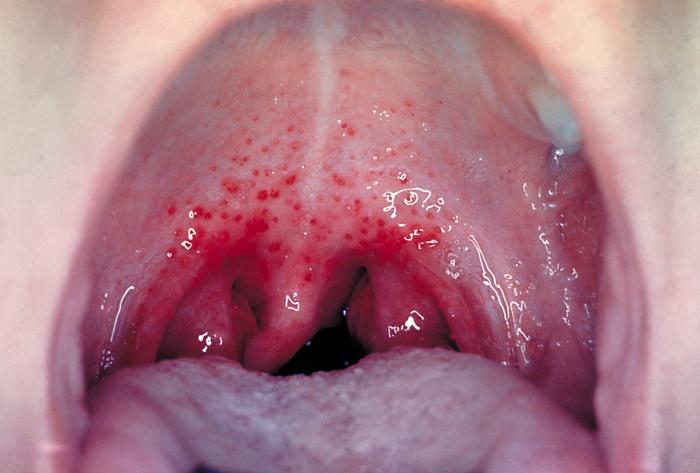strep throat

Strep throat. Image source: Center for Disease Control.
Strep throat is the most common throat infection caused by bacteria. It is found most often in children between the ages of 5 and 15, although it can occur in younger children and adults. Children younger than 3 years old can get strep infections, but these usually don't affect the throat. Strep throat infections usually occur in the late fall, winter, and early spring.
Cause
Strep throat is usually caused by group A streptococcus bacteria (specifically, Streptococcus pyogenes). Medically, the infection is called "acute streptococcal pharyngitis."
Transmission
You can get strep throat by direct contact with saliva or nasal discharge from an infected person. Most people do not get group A strep infections from casual contact with others. A crowded environment like a dormitory, school, or nursing home, however, can make it easier for the bacteria to spread. There have also been reports of contaminated food, especially milk and milk products, causing infection.
Symptoms
If you have strep throat infection, you will have a red and painful sore throat and may have white patches on your tonsils. You also may have swollen lymph nodes in your neck, run a fever, and have a headache. Nausea, vomiting, and abdominal pain can occur but are more common in children than in adults.
You can get sick within 3 days after being exposed to the germ. Once infected, you can pass the infection to others for up to 2 to 3 weeks even if you don't have symptoms. After 24 hours of taking antibiotics, you will no longer spread the bacteria to others.
Diagnosis
Your healthcare provider will take a throat swab to find out if you have strep throat infection. This will be used for a culture (a type of laboratory test) or a rapid strep test, which only takes 10 to 20 minutes. If the result of the rapid test is negative, you may get a followup culture, which takes 24 to 48 hours, to confirm the results. If the culture test is also negative, your healthcare provider may suspect you do not have strep, but rather another type of infection.
The results of these throat cultures will help your healthcare provider decide on the best treatment. Most sore throats are caused by viruses, and antibiotics are useless against viruses.
Treatment
If you have strep throat, your healthcare provider will prescribe an antibiotic. This will help lessen symptoms. After 24 hours of taking the medicine, you will no longer be able to spread the infection to others. Treatment will also reduce the chance of complications.
Current guidelines by expert groups recommend penicillin as the medicine of choice for treating strep throat because penicillin has been proven to be effective, safe, and inexpensive. Your healthcare provider may instruct you to the take pills for 10 days or give you a shot. If you are allergic to penicillin there are other antibiotics your healthcare provider can give you to clear up the illness.
During treatment, you may start to feel better within 4 days. This can happen even without treatment. Still, it is very important to finish all your medicine to prevent complications.


